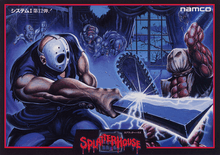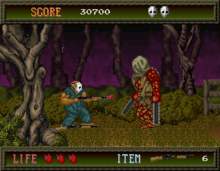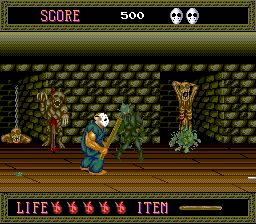Splatterhouse
Splatterhouse (スプラッターハウス, Supurattāhausu) is a beat 'em up arcade game developed and published by Namco. It is also subsequently the title of a series of games released in home console and personal computer formats. The game was heavily influenced by American slasher films and the works of horror writer H. P. Lovecraft, and is a homage to the violent horror films of the 1980s.
| Splatterhouse | |
|---|---|
 Japanese arcade flyer | |
| Developer(s) | Namco Splatter Team |
| Publisher(s) | Namco |
| Director(s) | Shigeru Yokoyama |
| Producer(s) |
|
| Designer(s) | Akira Usukura |
| Programmer(s) | PSQGL |
| Artist(s) | M. Ishida |
| Composer(s) |
|
| Series | Splatterhouse |
| Platform(s) | |
| Release |
|
| Genre(s) | Beat 'em up |
| Mode(s) | Single-player, multiplayer[lower-alpha 1] |
| Cabinet | Upright, cabaret, and cocktail |
| Arcade system | Namco System 1 |
| CPU | 2x Motorola 6809 @ 2.048 MHz, 1x Motorola M6809 @ 1.536 MHz, 1x Hitachi 6309 @ 1.536 MHz |
| Sound | 1x Yamaha YM2151 @ 3.57958 MHz, 1x Namco CUS30 @ 96 kHz, 1x DAC |
| Display | Horizontal orientation, raster, 288 x 224 resolution, 5121 palette colors |
Due to its violent nature as well as some questionable enemies, the TurboGrafx-16 port of Splatterhouse had a parental advisory warning printed on the front of the box that read, "The horrifying theme of this game may be inappropriate for young children... and cowards."
Gameplay

Splatterhouse is an arcade-style sidescrolling beat 'em up with platform elements,[2] in which the player controls Rick, a parapsychology student who is trapped inside West Mansion. After his resurrection by the Terror Mask, Rick makes his way through the mansion, fighting off hordes of creatures in a vain attempt to save his girlfriend Jennifer from a grisly fate.[3] Players of this game will also recognize a number of western horror film influences, such as Friday the 13th and Evil Dead II.
Similar to many sidescrolling beat 'em up games, Rick can only move in a two-dimensional environment. He has the ability to jump and can punch and kick. Rick also has a Special Attack, where he will perform a dropkick that sends him skidding along the ground, damaging any enemies he hits. Rick can also perform a low kick, low punch, and jumping attacks, as well as pick up and use various weapons placed in the levels.
All of the levels consist of walking left to right, with occasional auto-scrolling segments. However, alternative pathways through sections of the house are possible by falling down through holes or jumping up onto ladders. In this way, branching gameplay is possible, if only prevalent in the middle levels. Levels culminate in boss fights that take place in a single room. Unlike traditional sidescrolling fighters, boss fights have varying objectives and styles. Unlike most arcade games in the genre, Splatterhouse sends players back to checkpoints after losing lives or receiving a game over, discouraging "credit feeding" as a method of overcoming the various challenges.
Plot
Two students at the local university, Rick Taylor and Jennifer Willis, take refuge from a storm in West Mansion, a local landmark known as "Splatterhouse", for the rumors of hideous experiments purportedly conducted there by Dr. West, a renowned and missing parapsychologist. As they enter the mansion and the door shuts behind them, Jennifer screams.[3]
Rick awakens in a dungeon under the mansion having been resurrected thanks to the influence of the "Terror Mask", or in some versions, the "Hell Mask", a Mayan sacrificial artifact from West's house which is capable of sentient thought. The mask attaches itself to Rick, fusing with his body and transforming him into a monster with superhuman strength. With the mask's encouragement, Rick goes on a rampage through the dungeon and the mansion grounds, killing hordes of monsters.[3] Inside the mansion, Rick finds Jennifer, prone on a couch and surrounded by a throng of creatures that retreat upon his arrival. After their departure, Jennifer transforms into a slightly taller, fanged monster that attempts to kill Rick while begging him for help. Rick is forced to kill Jennifer, who transforms back to normal and thanks him before she dies. Infuriated, Rick tracks the remaining monsters to a giant, bloody hole in the mansion's floor. Upon entering it, Rick discovers that the mansion itself is alive. He follows a bloody hallway to the house's "womb", which produces fetus-like monsters that attack him.[4] Rick destroys the womb, which causes the house to burst into flames as it "dies".
Escaping the burning mansion, Rick comes across a grave marker. The Terror Mask releases energy into the grave, reviving a giant monster named "Hell Chaos" that claws its way up from the earth and attempts to kill Rick. Rick destroys the creature, which unleashes a tormented ghost that dissipates into a series of bright lights. As the lights vanish, the mask shatters, turning Rick back to normal, and he flees as the house burns to the ground and the credits roll. However, after he leaves and the credits end, the Terror Mask reassembles itself and laughs evilly for several seconds as the word "END" appears in the bottom right corner of the screen.
Ports

Splatterhouse was released in various home version ports on the TurboGrafx-16, FM Towns and PC. In addition to loss of graphical detail and removal of some sounds (standard for a port to less powerful hardware), the following edits were made to both the Japanese PC-Engine and North American TurboGrafx-16 versions of the game:
- The arcade version opens with an animation of Rick and Jennifer running through the storm and into the mansion, followed by an exterior shot of the mansion and the sound of Jennifer screaming. The console version opens simply with the exterior of the mansion, and no sound effects.
- The weapon in Stage 1 and Stage 2 is changed from a meat cleaver to a wooden stick.
- The overall violence and gore is toned down; enemies bleed less and the sound effects are less gruesome.
- The weapon for the Stage 4 boss is changed from an axe to a golden meat cleaver, the only cleaver in the game.
- The crawling hand in Stage 5 no longer flashes the middle finger.
- The death of the womb boss of Stage 6 is changed from a graphic spilling of embryonic fluids into a generic fiery explosion.
- The final boss uses different attacks.
- The end cut scene is changed from the original arcade ending, in which the mask breaks from Rick's face, followed by a shot of him walking away from the burning mansion and an additional cut scene showing the mask reform and laugh. The ending in the TurboGrafx-16 version only shows the mask explode, followed by a picture of West Mansion burning while the credits roll, and finally a large red and orange "End" is displayed.
The following edits are exclusive to the North American TurboGrafx-16 version:
- The Terror Mask is changed from a white hockey mask to a red mask with black accents. This is to keep Rick from looking too much like Jason Voorhees. The mask became more skull-like in later games.[4]
- The cathedral arches are removed from the Stage 4 boss chamber background and the altar is removed from the following cut-scene.
- The inverted cross boss of Stage 4 is replaced with a severed head.
- The final boss' grave is changed from a wooden cross to a tombstone.
The TG-16 version was released on the Wii's Virtual Console in Europe on March 16, 2007; in North America on March 19, 2007; in Japan on July 3, 2007; and in Australia on July 20, 2007.[5] The arcade version was released on May 26, 2009 on the Japanese Virtual Console.[6]
The FM Towns version, ported by Ving Co. and released only in Japan in 1992, is a pixel-perfect rendition of the original arcade, with no substantial changes apart from a new menu interface in the title screen. There was also an LCD handheld version released, titled Splatter House, but it is not a port of either games. It is considered to be an original Splatterhouse game in and of itself, though many elements in it are similar to the original game.[4]
In 2010, the game was ported to J2ME/BREW mobile phones, Windows Mobile and iOS platforms to coincide with the release of the remake.[7][8] The only change was in the Java-based mobile phone version, where Rick's mask is modeled after the skull-like one present in the remake. This change is not present in iOS version of the game, but it includes a "Splatter Rush" mode instead, where enemies continuously spawn from both ends of a wide screen. The remake also included the uncensored Japanese arcade version as an unlockable extra.[9]
It was also included as a part of the Namco Museum compilation for the Nintendo Switch, through the Nintendo eShop.[10][11]
Reception
| Reception | ||||||||||||||||||||||
|---|---|---|---|---|---|---|---|---|---|---|---|---|---|---|---|---|---|---|---|---|---|---|
| ||||||||||||||||||||||
In Japan, Game Machine listed Splatterhouse on their December 15, 1988 issue as being the sixth most-successful table arcade unit of the year.[19] Following its European release at the ATEI show in January 1989, Computer and Video Games gave the arcade version a positive review.[1]
Both the original arcade and TG-16 versions were well received. The game was praised for its graphics and music, and is notable for its graphic violence, which was uncommon at the time.
Wii Virtual Console release
IGN's Lucas M. Thomas said of Splatterhouse that "Putting aside the aesthetic design and just looking at the game on the merits of its mechanics, Splatterhouse is lacking."[3] He complained about the limited variety of attacks, one way scrolling, and censorship present in the North American console version. Thomas did, however, compliment the game's horror themes and music, noting that the console graphics, despite being "toned down", are a "good representation of the arcade original".[3] Frank Provo of GameSpot had similar complaints about Splatterhouse. "Ultimately, the problem with Splatterhouse is that there's not much to it. There are only seven levels, and you'll finish each one in just a few minutes," he wrote, going on to explain that the enemies all follow easily memorized patterns, making the game very simple to play.[15] In particular, Provo criticized the fact that the Virtual Console version was the censored console version, noting how he missed the meat cleavers and extra violence of the arcade game.[15]
Notes
- Up to 2 players with alternating turns.
References
- "Splatterhouse arcade game review". Solvalou.com. Retrieved 2016-03-11.
- Hicks, Brad (November 18, 2010). "Splatterhouse (Arcade/TG16) Retro Review". SwankWorld. Retrieved August 5, 2019.
- Lucas M. Thomas (2007). "Splatterhouse (1990) IGN review". Retrieved 2009-12-03.
- Rob Strangman (2007). "Splatterhouse at Hardcore Gaming 101". Retrieved 2009-03-13.
- https://www.nintendo.com/games/detail/BINOcJHKgIFhRL6gBmWv5DHBR60MpRkC
- Namco Bandai (2009). "Namco Bandai Games: VC". Retrieved 2009-03-13.
- Raby, Mark (October 30, 2010). "Classic Splatterhouse coming to your mobile phone". GamesRadar+. New York City: Future. Retrieved August 5, 2019.
- Crecente, Brian (November 12, 2010). "Phones Everywhere Getting 1988's Splatterhouse". Kotaku. New York City: Gizmodo Media Group. Retrieved August 5, 2019.
- McWhertor, Michael (April 8, 2010). "New Splatterhouse Also Throws In The Original 16-bit Trilogy". Kotaku. New York City: Gizmodo Media Group. Retrieved August 5, 2019.
- Conti-Groome, Leif (June 27, 2017). "Namco Museum is Coming to the Switch this Summer: Includes GameCube's Pac-Man Vs". Dualshockers. Retrieved June 29, 2017.
- NAMCO MUSEUM - Announcement Trailer (Trailer). Menlo Park, California: Google. April 12, 2017. Event occurs at 0:19. Retrieved April 21, 2017.
- "Splatterhouse for iPhone/iPad Reviews". Metacritic. Retrieved October 8, 2016.
- House, Michael L. (2014-12-11). "Splatterhouse - Overview - allgame". Web.archive.org. Archived from the original on December 11, 2014. Retrieved 2016-03-11.
- "CVG Magazine Issue 107". Archive.org. Retrieved 2016-03-11.
- Frank Provo (2007). "Splatterhouse Review". Retrieved 2009-12-03.
- "Classic Review Archive - Splatterhouse". Web.archive.org. 2008-04-08. Archived from the original on April 8, 2008. Retrieved 2016-03-11.
- Levi Buchanan (November 18, 2010). "Splatterhouse iPhone Review". IGN. Retrieved October 8, 2016.
- Calvert, Darren (2007-03-17). "Splatterhouse Review - TG-16". Nintendo Life. Retrieved 2016-03-11.
- "Game Machine's Best Hit Games 25 - テーブル型TVゲーム機 (Table Videos)". Game Machine (in Japanese). No. 346. Amusement Press, Inc. 15 December 1988. p. 25.